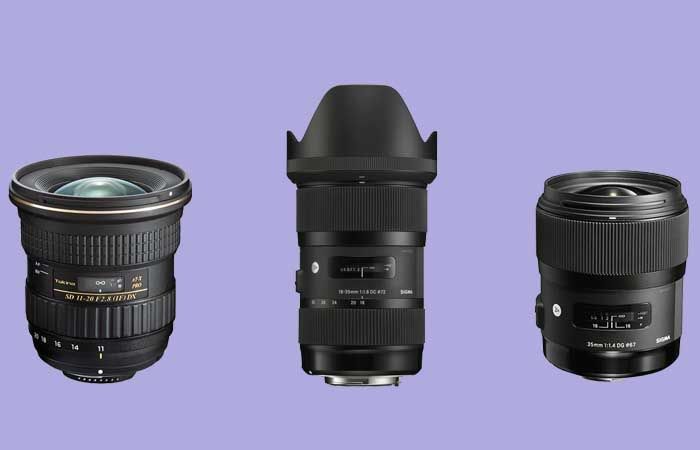With regards to Astrophotography, the focal point can customarily wind up being a higher priority than the camera. Great focal points permit you to get sharp pictures at wide openings, with minimal chromatic distortion, astigmatisms, or extreme lethargies.
In this article we will go over my picks for the best in class of the best Lenses for current Full casing DSLR cameras accessible today. It ought to be noticed that the title of this article could undoubtedly be traded for “best astrophotography lens” since a great deal of this will be based basically off of my experience and inclinations, and I would strongly suggest hearing more than one point of view.
1. The Sigma 14–24mm F2.8
The Sigma 14–24 is the immediate adversary to the Nikkor 14–24, which has been considered by numerous individuals to be the ruler of wide point focal points for scene and astro scene photography. Being many years fresher than the Nikkor, it has some little enhancements in corner sharpness, chromatic variation and vignette. Despite the fact that you presumably wouldn’t have the option to tell except if you looked at them next to each other.
As I referenced above it gives the idea that the Nikkor 14–24 has a marginally more extensive variant of 14mm by something under 1mm yet on the off chance that you need indisputably the greatest, at that point the Nikkor may be for you. I for the most part believe this focal point to be the victor since it not just conveys the much wanted 14–24mm with some quality upgrades over the longstanding ruler (the Nikkor) yet it is additionally accessible for Canon, Sony and Leica which makes it more flexible as an item.
Likewise a little close to home inclination I favor the Sigmas sunstars to the Nikkors. This may not make any difference to you or you may incline toward the Nikkor sunstars however in the event that you are intending to do any of that, you will need to contemplate that.
2. The Tamron 15–30 F2.8
The Tamron 15–30 has immediately become my preferred focal point. I don’t as of now own the Sigma 14–24 (however later on I couldn’t want anything more than to have one clinched). Anyway I have had the Tamron 15–30 for quite a long while at this point, and it has been my essential go to workhorse for the greater part of my scene and astro pictures.
More often than not the main two focal points I convey are the Tamron and the Nikkor 70–300 F4 (Which I would supplant with the Tamron proportionate in a heartbeat). What’s more, 90% of the time I am utilizing the Tamron. Believe it or not I even wind up attempting to change my organization to utilize the Tamron over the Nikkor in light of the fact that I discover its presentation far unrivaled.
In a considerable lot of my pictures I will in general notification that changing to the nikkor 70–300 brings a hotter, greener cast to it. I realize this is definitely not a logical correlation as it is two focal points of totally unique central lengths, anyway I do find that I am continually getting more normal and simpler discovered apparent adjusts reliably in the Tamron. You may definitely realize that shading amending a picture that is too cool is a lot simpler than rectifying and picture that is excessively warm, and the Tamron will in general reliably be a lot cooler making the RAWs a whole lot simpler to address in post.
3. The Nikkor 14–24 F2.8
The Nikkor is the longstanding ring champion is as yet utilized and confided in the absolute most prominent scene and astro scene picture takers on the planet. In the event that you are searching for a focal point with a longstanding demonstrated history of being one of the untouched best and trusted by the absolute most prominent picture takers alive… This is unquestionably your focal point.
Be that as it may, with a market of more up to date and more inventive focal points available I basically couldn’t put this focal point in first. It has been over 10 years since Nikon delivered this focal point and it is gradually meeting its opposition.
Recent Blog:- How to Analyze Risks in ISO 9001?
Try not to misunderstand me on the off chance that you as of now have the Nikkor it is as yet an incredible focal point, one of the most perfectly awesome available.. yet, in the event that you are hoping to add another focal point to your pack, I don’t see a lot of motivation to pick the Nikkor when you can get the sigma with improved execution for less expensive, or the Tamron with comparative presentation for less expensive. This focal point is as yet an excellent decision for Astrophotography, I simply believe that Nikon needs to refresh it with the goal for it to stay serious with the Sigma and Tamron.
End
Kindly note that the entirety of the focal points I have assessed here are for full casing cameras, and this is just the conclusions and exploration of a solitary picture taker. I would consistently suggest hearing more than one point of view, anyway I can guarantee you that the main three on this rundown will consistently be in the top level of most prominent wide edges accessible today.
On the off chance that you feel I missed something or didn’t specify a focal point, if it’s not too much trouble remark underneath so we would all be able to learn and become together! I will put forth a valiant effort to react as well and follow the remarks on these articles so we would all be able to keep awake to date.

